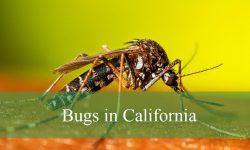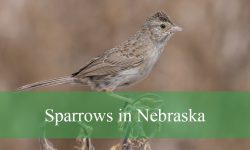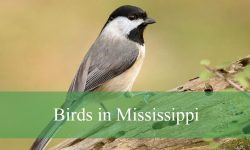Yellow and black butterflies are a captivating sight in the world of insects, known for their striking color combination and unique patterns. In this article, we will introduce you to 23 different types of yellow and black butterflies, accompanied by stunning pictures to help you identify and appreciate their beauty. Explore the diverse world of these butterflies as we showcase their unique characteristics, habitats, and more.
23 Types of Yellow and Black Butterflies and how to identify
Dappled Swallowtail (Papilio anactus)
The Dappled Swallowtail, scientifically named Papilio anactus, is a captivating butterfly native to the open woodlands and grasslands of Australia’s eastern coast. It boasts striking black wings adorned with vibrant yellow spots, and a hint of blue-green on its hindwings adds to its allure during flight. With a medium-sized frame and a wingspan of 60 to 100 mm, this butterfly plays a crucial role in its ecosystem by sipping nectar from various flowers for pollination. Its larvae, meanwhile, feed on host plants like citrus trees.
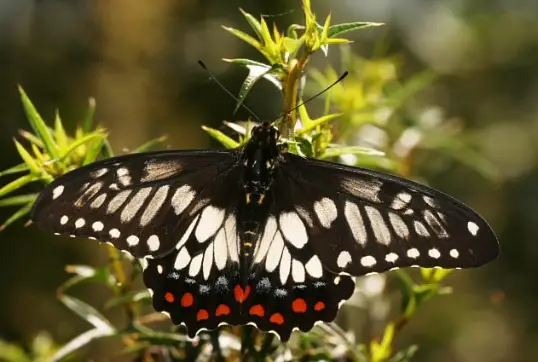
Reproduction is fascinating in this species, as the female lays fertilized eggs on host plants, and the hatched larvae go through metamorphosis to become magnificent butterflies. Despite their captivating presence, Dappled Swallowtails have a relatively short lifespan of 3 to 4 months, leaving a lasting impression on their habitats through their beauty and ecological contributions.
Sao Paulo Swallowtail (Papilio anchisiades)
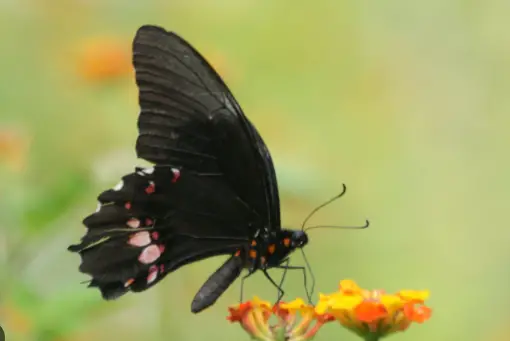
The Sao Paulo Swallowtail, or Papilio anchisiades, is a Brazilian butterfly native to the Atlantic Forest biome. It has striking black wings with bold yellow stripes and spots, with females being more yellow than males. This medium-sized butterfly has a wingspan of 90 to 100 mm and feeds on various plants, including citrus trees. Reproduction involves females laying eggs on host plants for larvae to grow. Despite its beauty and ecological role, this butterfly has a short lifespan of about two weeks, leaving a mark on the Atlantic Forest in Brazil.
Schrenck’s Emperor (Teinopalpus aureus)
The Schrenck’s Emperor, scientifically named Teinopalpus aureus, is a stunning butterfly found in coniferous forests across China, Korea, and Russia. It sports vibrant yellow stripes and spots on its black wings with iridescent blue-green scales. This large species boasts a wingspan of 78 to 102 mm and feeds on flower nectar, aiding in pollination.
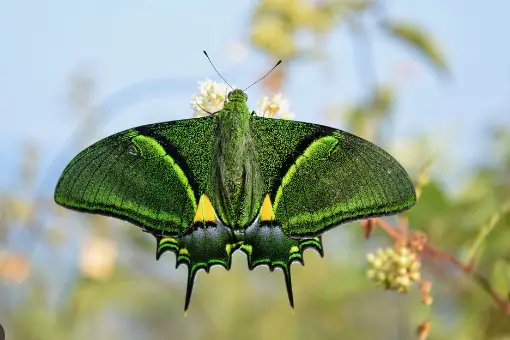
Males of this species exhibit brighter colors and patterns, particularly during mating when they release a pheromone to attract females. Despite their captivating beauty and intriguing behavior, the Schrenck’s Emperor has a relatively short lifespan of just 3 to 4 weeks. During this brief time, they leave an enduring impression in their forest homes, a cherished sight in their natural habitat.
Black-veined White (Aporia crataegi)
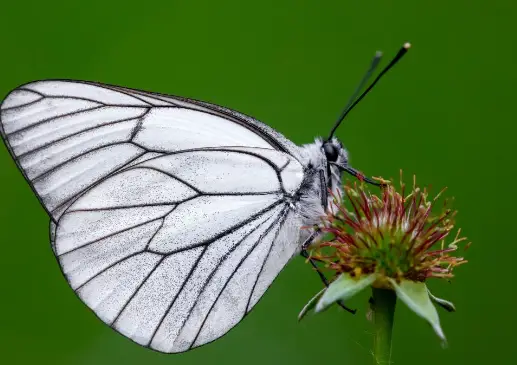
The Black-veined White, or Aporia crataegi, is a butterfly found in Europe and Asia, commonly seen in wooded areas and open countryside. It has distinctive white wings with intricate black markings, more extensive in females. With a wingspan of 5 to 7.5 cm (2 to 3 inches), these butterflies feed on flower nectar as adults and Rosaceae family plant leaves as larvae. They lay eggs on leaves, and after hatching, the larvae feed until they form a chrysalis. Despite their delicate appearance, adult Black-veined Whites live for several weeks, contributing to their ecosystems through their presence and ecological roles.
Scarce Swallowtail (Iphiclides podalirius)
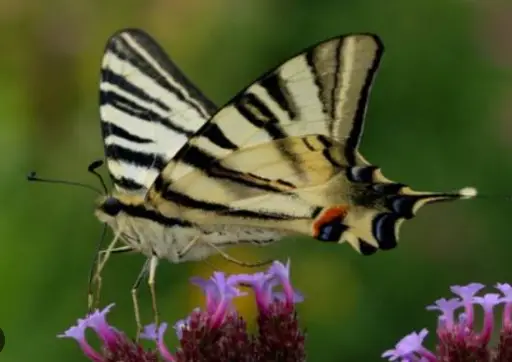
The Scarce Swallowtail, or Iphiclides podalirius, is a butterfly found in Europe and Asia, often seen in woodlands and gardens. It has distinctive white wings with black and yellow markings, featuring blue and red eyespots on the hindwings. With a wingspan of 6 to 8 cm (2.3 to 3.1 inches), adults feed on flower nectar and larvae eat carrot family plant leaves. Reproduction is straightforward, with females laying eggs on leaves for larvae to feed on before forming a chrysalis. Adult butterflies have a short lifespan, usually only a few weeks during their life cycle.
African Giant Swallowtail (Papilio antimachus)
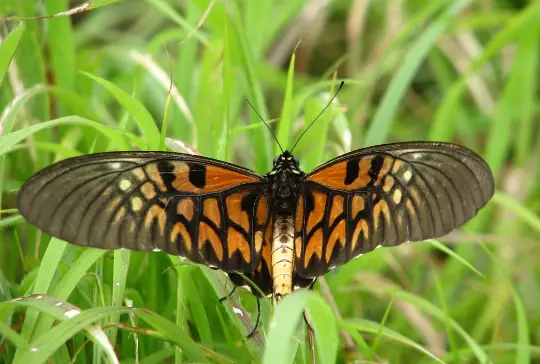
The African Giant Swallowtail, or Papilio antimachus, is a striking butterfly native to Sub-Saharan Africa, found in lush forests and woodlands. It features black wings with vibrant yellow spots and lines, and its hindwings have long tails with blue and orange eyespots. With an impressive wingspan of 12 to 20 cm (4.7 to 7.8 inches), these butterflies primarily feed on flower nectar for pollination, while their larvae prefer citrus family plant leaves. Reproduction involves females laying eggs on leaves for larvae to consume before forming a chrysalis. Despite their grandeur, adult African Giant Swallowtails have a relatively short lifespan, living for several weeks, yet they continue to play a significant role in Sub-Saharan African ecosystems.
Common Brimstone (Gonepteryx rhamni)
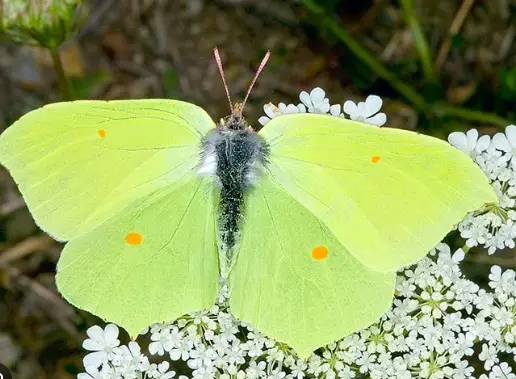
The Common Brimstone, or Gonepteryx rhamni, is a short-lived butterfly of a few weeks found in Europe and North Africa. often seen in gardens, fields, and woodlands. Males have bright yellow wings, while females have pale green-yellow wings, both with white and black markings. With a wingspan of 6 to 7.5 cm (2.3 to 3 inches), adults feed on flower nectar, while larvae eat buckthorn family plant leaves. Reproduction involves females laying eggs on leaves.
Yellow Pansy (Junonia hierta)
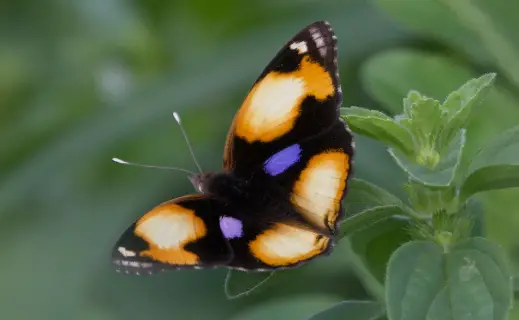
The Yellow Pansy, scientifically known as Junonia hierta, is a charming butterfly found in Africa and Asia, often seen in grasslands, meadows, and disturbed areas. With a modest wingspan of 5 to 7 cm (2 to 3 inches), these butterflies sustain themselves by sipping nectar from various flowers as adults, while their larvae feed on plant leaves. Reproduction involves females laying eggs on leaves, and despite their short lifespan of several weeks, Yellow Pansies contribute to their ecosystems through their vibrant presence.
Yellow Jezebel (Delias agostina)
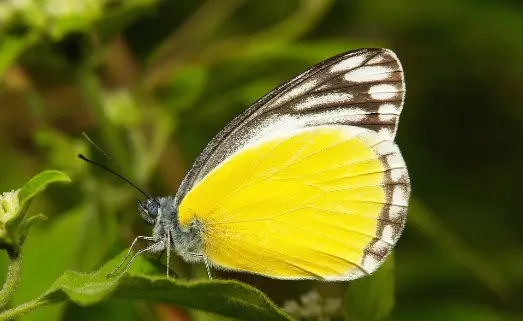
The Yellow Jezebel, scientifically known as Delias agostina, is a charming butterfly native to Australia and nearby islands. It can often be seen in forests, woodlands, and gardens, displaying vibrant yellow wings with intricate black markings. Males have more black markings than females. With a modest wingspan of 4 to 5.5 cm (1.5 to 2.1 inches), adult Yellow Jezebels feed on nectar, aiding in pollination, while their larvae consume citrus family plant leaves. Reproduction involves females laying eggs on leaves, and the larvae later transform into chrysalises.
Common Yellow Swallowtail (Papilio machaon)
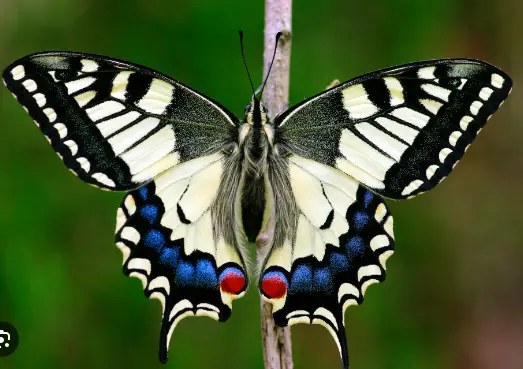
Papilio machaon, sometimes known as the Common Yellow Swallowtail, is a widespread butterfly that may be found in Europe, North Africa, and Asia. It is frequently observed in grasslands, meadows, and gardens. They provide beauty to their surroundings with their beautiful yellow wings that are ornamented with black stripes, spots, and bright blue and red eyespots on the hindwings. While their larvae prefer dill and fennel leaves, adult swallowtails, which have a wing span of 6 to 8 cm (2 to 3 inches), sip nectar from a variety of flowers to help with pollination. Females reproduce by depositing eggs on leaves, and the eggs hatch into larvae that eventually pupate into chrysalises.
Citrus Swallowtail (Papilio demodocus)
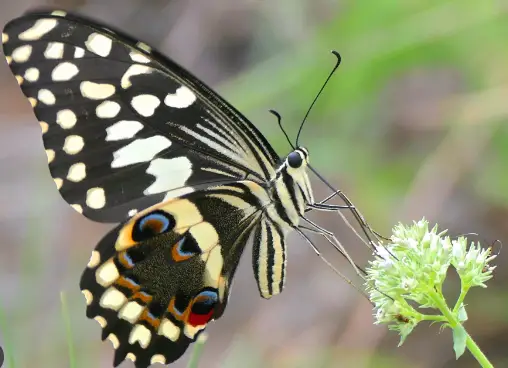
The Citrus Swallowtail, or Papilio demodocus, is a butterfly found in Sub-Saharan Africa and Madagascar, often near citrus trees. Predominantly black with striking yellow spots and a distinctive long ‘tail’ on their hindwings adorned with blue and red eyespots, they have an impressive wingspan of 8 to 11 cm (3 to 4 inches). Their diet consists of citrus tree leaves, aligning with their habitat. Females lay eggs on the underside of these leaves, and the larvae consume them until they pupate into chrysalises. This butterfly not only boasts a striking appearance but also plays a vital role in its ecosystem, especially in citrus groves.
Southern Dogface (Zerene cesonia)
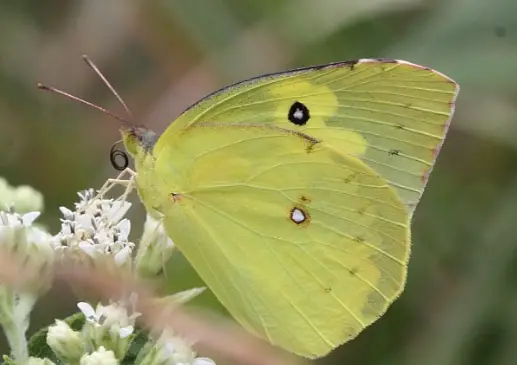
The Southern Dogface butterfly, or Zerene cesonia, is a charming species found in open fields, grasslands, and sandy areas in the United States, Mexico, and Canada. Its wings feature distinctive yellow and black markings, with males having a larger dogface marking than females. With a wingspan of 2 to 3 inches, they are relatively small yet beautiful. Larvae feed on pea family plants, while adults sip nectar from flowers. Reproduction occurs in spring and summer, with females laying eggs on host plant leaves or stems, ensuring the continuation of this lovely butterfly’s life cycle.
Cloudless Sulphur (Phoebis sennae)
The Cloudless Sulphur butterfly, or Phoebis sennae, is a vibrant species found throughout the Americas, in meadows, fields, open woods, and gardens. Recognized by its brilliant yellow wings without markings, males have a slightly more intense yellow hue than females. With a wingspan of 2.5 to 3.5 inches (6.4 to 8.9 cm), they are of medium size.
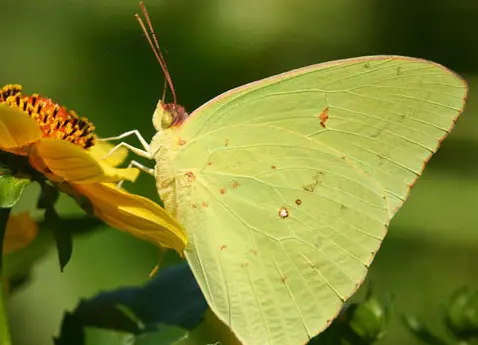
Their diet varies across life stages, with larvae feeding on specific tree leaves like wild senna and partridge pea, while adults sip nectar from a variety of flowers. Reproduction involves females laying eggs on host plant leaves in batches, with hatching caterpillars devouring these leaves. Their pupal stage lasts about two weeks.
Despite their vibrant presence and ecological importance, Cloudless Sulphur butterflies have a relatively short adult lifespan, typically lasting up to two weeks. In this brief time, they contribute to pollination, enhance their habitats’ beauty, and play essential roles in local ecosystems.
Old World Swallowtail (Papilio machaon)
The Old World Swallowtail, scientifically known as Papilio machaon, is a versatile butterfly commonly found across various Old World habitats. It boasts bright yellow wings adorned with bold black stripes and spots, as well as captivating blue and red markings, including large round red spots on the hind wings. With a wingspan ranging from 2.5 to 3.5 inches (6.4 to 8.9 cm), it’s of medium size.
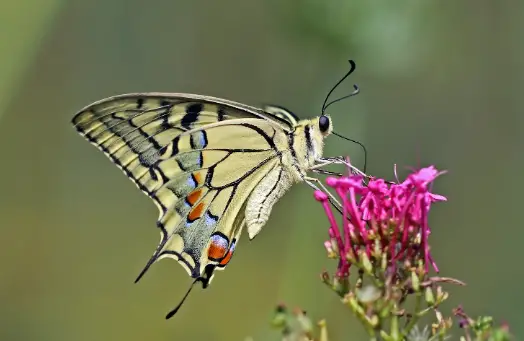
Their diet changes throughout their life cycle, with larvae feeding on plants like carrot, dill, parsley, and fennel, while adults sip nectar from different flowers. Reproduction involves females laying eggs on host plant leaves, and the hatching caterpillars consuming these leaves. The pupal stage lasts approximately two weeks.
Despite their remarkable appearance, Old World Swallowtail butterflies enjoy an extended adult lifespan, typically living up to one month.
Giant Swallowtail (Papilio cresphontes)
The Giant Swallowtail, scientifically known as Papilio cresphontes, is a versatile butterfly commonly found in diverse habitats across North and Central America, including forests, woodlands, and citrus groves. Its striking appearance features large wings adorned with bold black and yellow stripes, complemented by beautiful blue crescents on the hind wings. With a wingspan ranging from 4 to 6.5 inches (10 to 16.5 cm), these butterflies are indeed majestic.
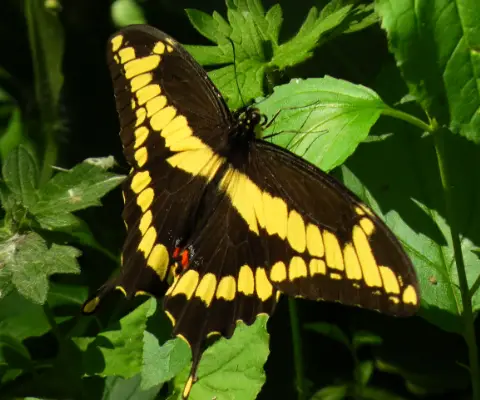
Throughout their life cycle, Giant Swallowtails exhibit a varied diet. As larvae, they voraciously feed on the leaves of citrus trees like oranges and lemons, while as adults, they switch to sipping nectar from various flowers, especially those with fragrant blooms.
Reproduction is a crucial process for this species. Females lay their eggs on the leaves of host plants, and upon hatching, the caterpillars eagerly consume these leaves. The pupal stage lasts for approximately two weeks. Giant Swallowtail butterflies have a relatively extended adult lifespan, typically living up to one month.
Canadian Tiger Swallowtail (Papilio canadensis)
The Canadian Tiger Swallowtail, or Papilio canadensis, is a butterfly enjoy a relatively long adult lifespan of up to one month, commonly found throughout North America in various habitats like forests, meadows, and fields. These eye-catching butterflies sport yellow wings adorned with bold black stripes, with females having more blue on their wings than males. They typically have a wingspan ranging from 2.75 to 4 inches (7 to 10 cm).
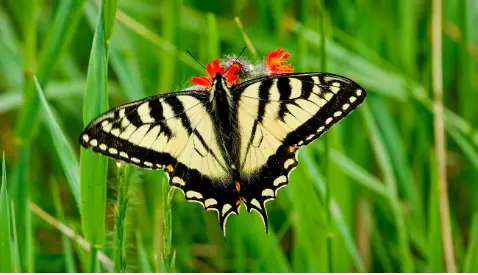
During their lifecycle, Canadian Tiger Swallowtails exhibit a diverse diet. As larvae, they devour the leaves of trees such as aspen, birch, and wild cherry. As adults, they switch to sipping nectar from various flowers, including milkweed and thistles.
Reproduction is a vital part of their life cycle. Females meticulously lay their eggs on host trees’ leaves, and upon hatching, the caterpillars feed on these leaves for several weeks. The pupal stage lasts approximately two weeks.
Anise Swallowtail (Papilio zelicaon)
The Anise Swallowtail, or Papilio zelicaon, is a butterfly commonly found in western North America in habitats like meadows, fields, and gardens. These eye-catching butterflies sport yellow and black wings with distinctive blue spots on the hind wings, more prominent in females. Their wingspan typically ranges from 2.25 to 3.5 inches (5.7 to 8.9 cm).
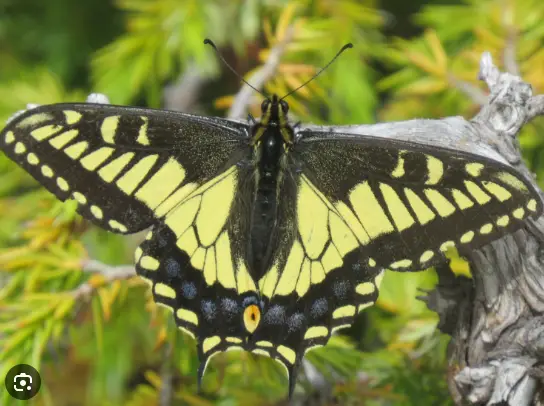
In terms of diet, their life cycle begins with larvae voraciously consuming leaves from carrot family plants like parsley, dill, and fennel. Once they reach adulthood, they switch to nectar from various flowers, including the butterfly bush and milkweed.
Reproduction involves females carefully laying eggs on host plant leaves. Emerging caterpillars then feed on these leaves for around three weeks before entering a two-week pupal stage.
Despite their moderate size, Anise Swallowtail butterflies have a relatively short adult lifespan, typically living up to two weeks.
Two-tailed Swallowtail (Papilio multicaudata)
The Two-tailed Swallowtail, scientifically known as Papilio multicaudata, is a sizable butterfly commonly found in western North American habitats like mixed forests, foothills, and deserts. Recognizable by their large yellow wings with bold black stripes and two long hindwing tails, these butterflies typically have a wingspan ranging from 3.5 to 5.5 inches (8.8 to 14 cm).
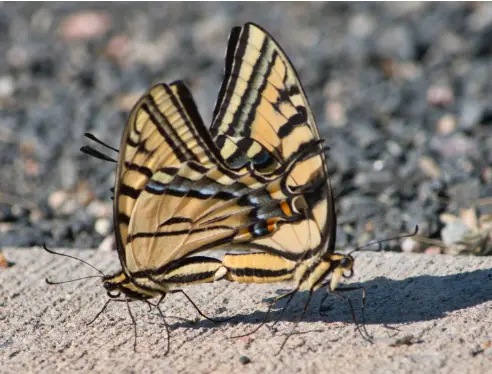
Their diet changes throughout life; as larvae, they consume the leaves of trees like chokecherry, saskatoon, and willow, while as adults, they sip nectar from various flowers, including milkweed and thistle. Reproduction involves females laying clusters of eggs on host plants, and the emerging caterpillars feed on these leaves. The pupal stage lasts for about two weeks. This butterfly has a life cycle of about 1 month.
Western Tiger Swallowtail (Papilio rutulus)
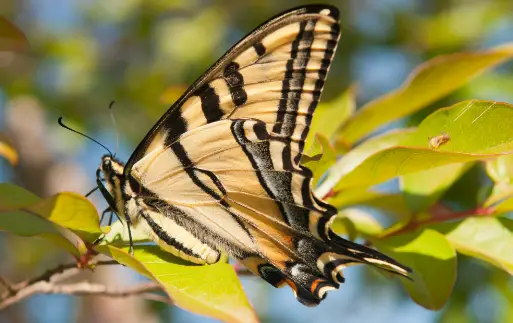
The Western Tiger Swallowtail, native to western North America, boasts striking yellow wings with bold black stripes, blue and orange spots near the tail, and wider stripes on females. They span 3.5 to 6 inches in size, feeding as caterpillars on tree leaves and as adults on flower nectar. Reproduction involves egg-laying on host trees, followed by caterpillar development and a two-week pupation period before becoming beautiful adult butterflies. Despite their brief two-week lifespan, they grace their habitats with vivid colors and elegance, leaving a lasting impact on observers.
Eastern Tiger Swallowtail (Papilio glaucus)
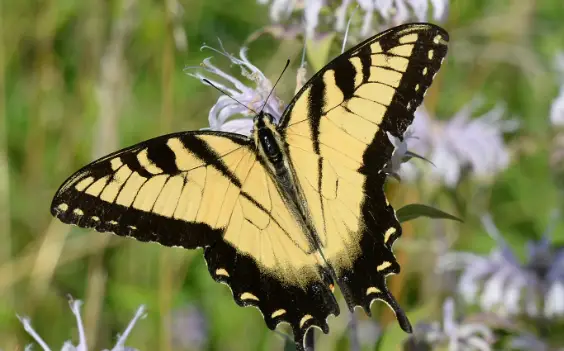
The Eastern Tiger Swallowtail, known as Papilio glaucus, is a striking butterfly found throughout the eastern United States. It sports bold black and yellow wings, with females having a slightly larger wingspan and an extra black stripe compared to males. These butterflies can have a wingspan ranging from 3.5 to 6 inches. As caterpillars, they feed on various tree leaves, and as adults, they enjoy nectar from flowers like azalea and milkweed. Reproduction involves females laying eggs on host tree leaves, leading to caterpillars with green bodies, black stripes, and eye-like spots. Their pupal stage lasts about two weeks before they emerge as magnificent adult butterflies. Despite their short two-week lifespan as adults, they bring color and grace to their surroundings, leaving a lasting impression on observers.
Yucca Giant Skipper (Megathymus yuccae)
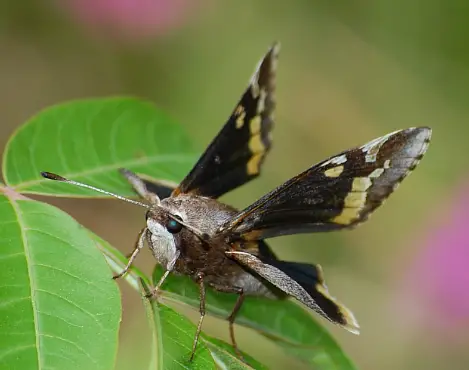
Yucca giant skippers (Megathymus yuccae) are robust butterflies known for their rarity and swift flying males. They inhabit the Southern United States and Northern Mexico, favoring a variety of environments, particularly yucca plants. Their wings are brown with yellow spots, and their undersides feature black and gray mottling.
Southern Festoon (Zerynthia polyxena)
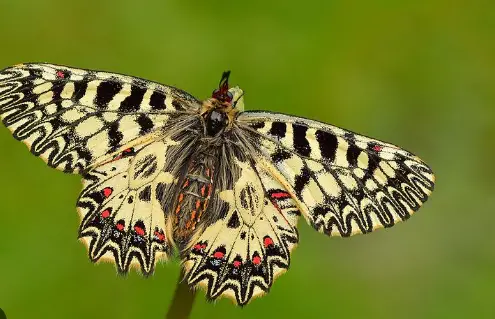
The southern festoon (Zerynthia polyxena) is often confused with the Spanish festoon due to their similar appearance. They have intricate wing patterns and are locally scarce despite being widespread in their range. They can be found in warm, open habitats throughout Central and Southern Europe, from the Balkans to Kazakhstan, including grassy meadows, riverbanks, rocky cliffs, vineyards, and cultivated lands. These butterflies have light yellow wings with intricate black and brown patterns, red spots, and slightly longer and lighter females. The key distinguishing feature from the Spanish festoon is the presence of blue on their hindwings.
Northern Chequered Skipper (Carterocephalus silvicola)
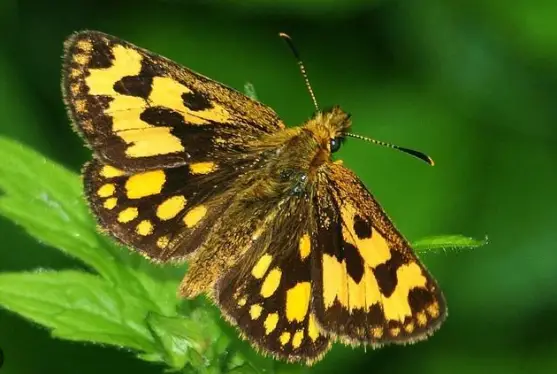
The northern chequered skipper (Carterocephalus silvicola) is a robust member of the skipper family, which includes around 4,000 species, with only 40 native to Europe. They are commonly found in central and southern Finland, particularly in damp meadows and lush forests. These butterflies, known for their larger heads and wings, are frequently seen in flight during May and June. They have yellow wings with distinctive blackish-brown spots and patterns.
Conclusion
Yellow and black butterflies come in a remarkable variety of species, each with its own unique features and charm. We hope this article has provided you with valuable insights and beautiful images of these fascinating creatures. Whether you’re a butterfly enthusiast or simply appreciate the wonders of nature, these 23 types of yellow and black butterflies are a testament to the diversity and beauty of the natural world.

